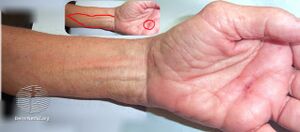Lymphangitis
| Lymphangitis | |
|---|---|
| Other names: Inflamed lymph vessels[1] | |
 | |
| Forearm lymphangitis due to cellulitis of the hand | |
- For discussion of the condition in horses, see Equine lymphangitis.
Lymphangitis is an inflammation or an infection of the lymphatic channels[2] that occurs as a result of infection at a site distal to the channel. The most common cause of lymphangitis in humans is Streptococcus pyogenes (Group A strep), hemolythic streptococci, and in some cases, mononucleosis, cytomegalovirus, tuberculosis, syphilis, and the fungus Sporothrix schenckii.[3] Lymphangitis is sometimes mistakenly called "blood poisoning". In reality, "blood poisoning" is synonymous with sepsis.
Lymphatic vessels are smaller than capillaries and tiny venules and are ubiquitous in the body. These vessels are fitted with valves to direct flow in only one direction. Fluid diffusing through the thin walled small capillaries should be collected and the lymphatic system does just that: a fluid rich in protein, minerals, nutrients, and other substances useful for tissue growth. As well as essential nutrients, the lymphatic system can also transport or carry cancer cells, defective or damaged cells, and pathogens such as bacteria and viruses, as well as foreign bodies and organisms. The lymph nodes are found in close proximity to unique white blood cells that engulf or metabolize pathogens (bacteria and viruses) and defective or cancerous cells, preventing infections and malignant cancer cells from spreading.
[4] Infection spreads out of the wound site to enter the lymphatic system. The wound may be small or it may be an abscess constantly feeding bacteria into the lymphatic system. After infection, lymph nodes enlarge. Ear, skin, nose, and eye infections can spread into the lymphatic system. Red streak in the skin along the direction of regional lymph nodes indicates lymphatic involvement. Infection may spread within hours and can cause septicemia and death.
Symptoms
[5] Warm skin over site of infection. The person may also have chills and a high fever - between 38 and 40 degrees Celsius - along with moderate throbbing pain and swelling. The red streaks can be clearly outlined and demarcated or just barely visible, particularly in dark-skinned patients. Malaise, anorexia, tenderness at the site of infection, skin ulcers (rare symptom of lymphangitis), rapid pulse, and enlarged, swollen, and tender lymph nodes. If these symptoms are absent, it is suggestive of other underlying disorders such as tuberculosis, lymphoma, or Hodgkin’s disease. A person with lymphangitis should be hospitalized and closely monitored by medical professionals.[6] When the inferior limbs are affected, the redness of the skin runs over the great saphenous vein location and can be confused for thrombophlebitis.[citation needed]
Chronic lymphangitis is a cutaneous condition that is the result of recurrent bouts of acute bacterial lymphangitis.[7]: 261
-
Lymphangitis following accidental wound
-
Lymphangitis resulting from bed bug bites
Diagnosis
To detect and identify infectious agents such as streptococci and staphylococci bacterial strains blood tests and bacteria cultures can be used. Bacteria culture is suitable for identifying infectious agents in cases of severe lymphangitis that do not respond well to treatment.[citation needed]
DDx
Infectious lymphangitis should be differentiated from other conditions such as superficial thrombophlebitis (swelling is local to the affected vein), cat scratch (swellings feels hard to the touch), acute streptococcal hemolytic gangrene and necrotizing fasciitis (infected area crackles to the touch and the patient looks very ill).[citation needed]
Treatment
Both drug and non-drug based treatment options are available to treat with lymphanginitis. The wound should be treated properly, dead tissues should be removed from the wound site, and pus drained. Applying heat to the affected lymph node using hot, moist compresses, or heating pads. Immobilizing and elevating the affected limb whenever it is possible, and administering analgesics to control pain.[citation needed]
[8] If a local infection is invasive, immediate antibiotic drug therapy is required. Streptococci strains are the most common infectious agents and respond well to cephalosporins – cephalexin at a dose of 0.5 mg for between 7 and 10 days – or extended-spectrum penicillin. Methiciline-resistant staphylococcus aureus is common in communities and hence the need to use improved antibiotic drugs such as trimethoprim-sulfamethoxazole for 7 to 10 days. Naficillin, oxacillin, and dicloxacillin are also effective against infections of the lymphatic system.[citation needed]
See also
References
- ↑ "Lymphangitis : MedlinePlus Medical Encyclopedia". medlineplus.gov. Archived from the original on 4 June 2019. Retrieved 4 June 2019.
- ↑ "Lymphangitis" at Dorland's Medical Dictionary
- ↑ Sporothrix spp. Archived 2013-04-14 at archive.today Doctor Fungus
- ↑ "Medically Sound: Awash with Protein-rich Fluid, the Lymphatic System Invites for a Direct Invasion by Microbes". Medically Sound. 2020-11-02. Archived from the original on 2020-11-12. Retrieved 2020-11-07.
- ↑ "Medically Sound: Awash with Protein-rich Fluid, the Lymphatic System Invites for a Direct Invasion by Microbes". Medically Sound. 2020-11-02. Archived from the original on 2020-11-12. Retrieved 2020-11-07.
- ↑ Prentice, Arnheim's Principles of Athletic Training, 12th edition, pg. 988.
- ↑ James, William D.; Berger, Timothy G.; et al. (2006). Andrews' Diseases of the Skin: clinical Dermatology. Saunders Elsevier. ISBN 0-7216-2921-0.
- ↑ "Medically Sound: Awash with Protein-rich Fluid, the Lymphatic System Invites for a Direct Invasion by Microbes". Medically Sound. 2020-11-02. Archived from the original on 2020-11-12. Retrieved 2020-11-07.
External links
| Classification | |
|---|---|
| External resources |

